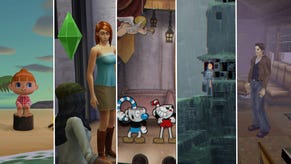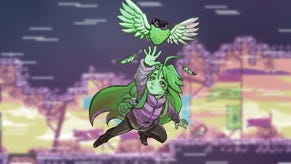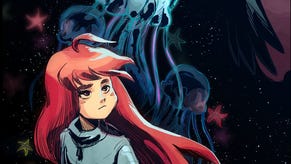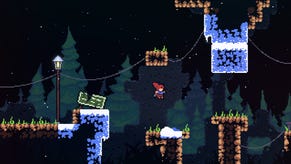Celeste Review: Mountains May Depart
In the new platformer from the creator of Towerfall, it's just you, a mountain, and a heap of anxiety.
This article first appeared on USgamer, a partner publication of VG247. Some content, such as this article, has been migrated to VG247 for posterity after USgamer's closure - but it has not been edited or further vetted by the VG247 team.
I don't remember my first panic attack, but I remember the thousands I've probably had since in my short lifetime. They all start the same: with my heart beating fast, my throat feeling like its constricting, my brain zig-zagging in panic. But I always try to remember what my nana once told me to calm me down: focus on something small and singular, and it will bring you back to reality.
I didn't expect Celeste, the new game from Towerfall creator Matt Makes Games to bring me back to those moments in my life.
Celeste is a difficult, intricately designed platformer that doesn't mince the harshest leanings of the genre. (Over the course of my 12 hours playing through the base game's seven chapters, I died around 3000 times. About 1200 of those were on the game's lengthy final chapter alone.) Before becoming the full-fledged, beautifully pixelated game that it is today, its concept was born as a bite-sized, 128x128 pixel, 16-color arcade game for the "fantasy video game console" Pico-8. The core that was in the itty-bitty version of Celeste remains the same in the newly expanded game: just a girl climbing a big ol' mountain. Only it's much more detailed now, and broader in scope.
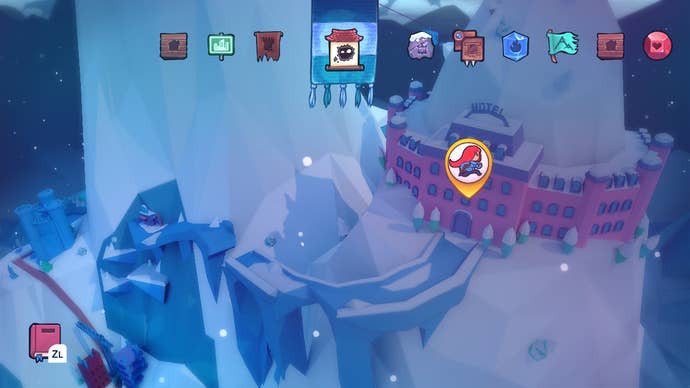
The game's fragmented by chapters, with each chapter feeling longer than the last as you hit more difficult passages. The chapters are divided by rooms, which are essentially teensy little levels with some primary challenge to them: maybe it's just finding an exit, or trying to get that hard-to-reach collectable strawberry floating in the distance. As you progress through the game, the levels get harder; new ideas are thrown at the screen, from bubbles that project you in directions to a galaxy-clad block that your plucky heroine Madeleine can dash through with intergalactic style, as long as a wall isn't on the other side of it.
As a platformer, Celeste operates with ease. You climb, duck, wall jump, and most importantly, dash. Whether on foot or mid-air, you're always utilizing that dash. If you're hit just once by something, whether it's falling onto a bed of spikes or the unknown sky below, you're dead (but it's an automatic respawn at the start of the current room you reside in). In the game's opening chapter, which feels like a testing ground for what's to eventually come, these abilities are parsed out individually to play with, from a moving platform you grab onto the side of and let go of at the opportune time to send Madeleine flying, to a series of disintegrating platforms you must jump across with caution.
Then, things get a little more complicated; though the dastardly mountain never throws anything at you until you're ready for it. In a middle-game chapter, I found myself in a room that I didn't understand. There was a block with an arrow on it that was pointed directly to the left; when I jumped on it, it only moved that direction too, even with other things in its way. Eventually I would hit the spikes in its trajectory, the block would explode, and that was it. I pondered how to move across this particular room before eventually giving up and turning back.

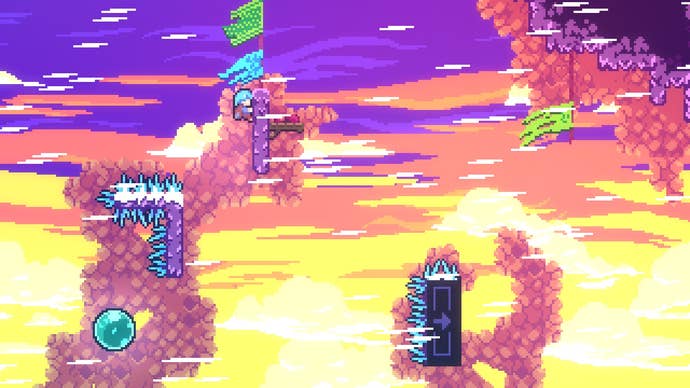
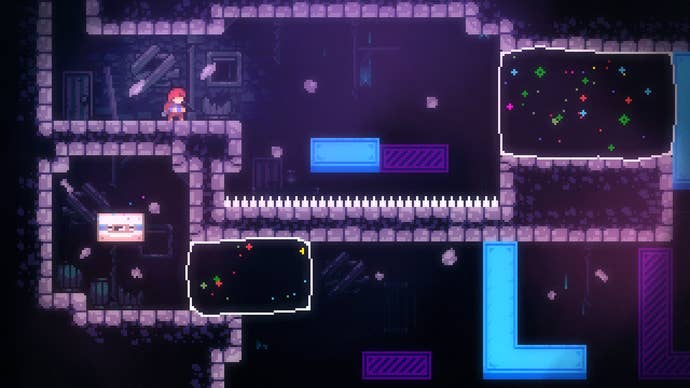
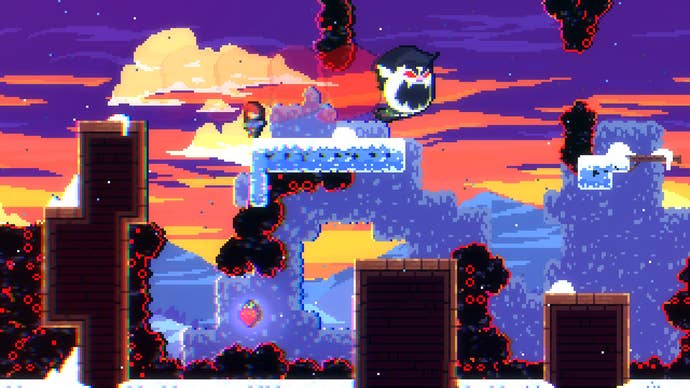
I travelled upwards instead, and found myself in another room. This room had a similar block on it—the one with the arrow—but the space I had to move on it was much wider. Basically by accident, I figured out that I could shift the direction of the block if I was standing on the button on top of it, directing the block away from things to obstruct it while leading me across the room unscathed. The exit happened to drop me off just where I was stuck on before: the room with the block and the limited space to navigate it in. Knowing now that I could shift it to my fancy, I got across the room without any problems.
The whole sequence feels designed in this very particular way—to teach the mechanic with the blocks before introducing me to a harder sequence utilizing it, or maybe I was just dumb the first time I came across it. But it made me feel more like it's a case of the former: with the game gently teaching me something new, and then throwing something at me immediately after to really test if I absorbed that knowledge. Death is always a lesson.
Those sorts of inventive, intuitive-feeling moments are scattered all across Celeste. As you move through the chapters, the music kicks up steadily too, as if the beat is encouraging you that yes, you're making actual progress. As if the surerer you become in your abilities, the more frenetic the chapter plays out. But the marriage of audio, visual, and mechanics is only just part of what makes Celeste great.
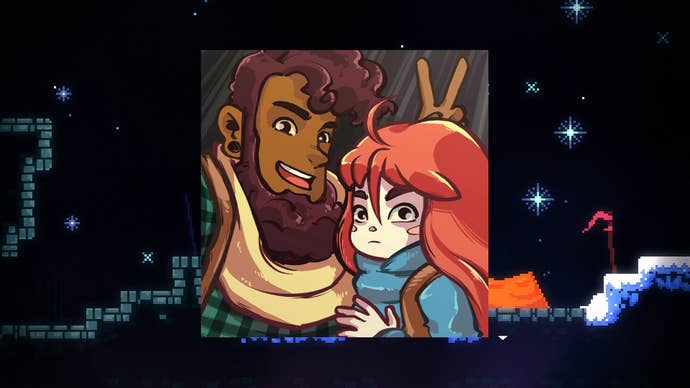
What really makes the game shine in-between all the chaotic but elegant ways to hop across the game's rooms, is the surprising heart at the center of it all. In the game, you're controlling Madeleine, a spontaneous mountain climber who travels to Celeste Mountain in order to accomplish something by trying to reach the looming mountain's summit after a series of life choices has led her astray. She's stubborn in this goal, for better or worse. She meets others across her journey too, from the ghostly, ever-accommodating hotel manager Mr. Oshiro to fellow hiker Theo, who may be the nicest human to ever exist. The characters are few in Celeste, but they all make their own unique impact on both the quaint, relatable story Celeste weaves, and on Madeleine herself.
Madeleine, we quickly learn, struggles with anxiety and depression, which end up manifesting in eerie things on her big climb. The game never feels hamfisted in its approach towards these topics, as I worried they might when they first began making an appearance in the game's Animal Crossing-like, gibberish-sounding dialogue (that is readable in English in text boxes, of course). By Celeste's end, I connected a lot with Madeleine. The hardships we both faced on the steep, strenuous climb across the many hours felt symbolic to those who live with anxiety and the like. Even when the game crashed on me towards the end of a pivotal chapter (this only happened one time) and I had to restart the chapter from the middle with at least an hour of progress lost, I wasn't even that distressed. It comes with the territory. Sometimes life sucks, just like this impossible belly of spikes I have to jump over vertically on a mountainside.

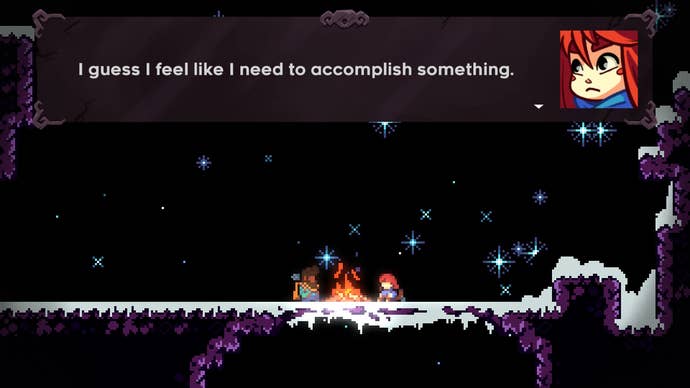
There's more in Celeste after the credits roll too. There's the B-Sides that you uncover in each chapter, which are seemingly the rooms that were left on the cutting room floor—probably because they were too hard—that all feature remixes from different musicians. There's the encouraged speedrunning aspect of Celeste too (it's not often that a game has a "speedrun timer" buried in its menu). I hunted for replay value by going back to collect a few strawberries I missed on an early chapter, only to run through the chapter in a total of 15 minutes, a far cry from the original 45 minutes it once took me.
There's endgame content beyond retreading old levels too. In Celeste's postgame, there are more chapters to play, unlocked by special collectables (that aren't that familiar fruit) found scattered across the game's chapters. Approaching the initial postgame chapter, I was greeted by a giant wall. I'm told to "prove" myself to the mountain before travelling any further. And in the weeks to come of diving back in to run across those familiar levels in hunt of new secrets and other seemingly impossible routes, I welcome the refreshed challenge. Just like in life.
ConclusionPlatformers, especially those with a retro flair, come along often. But so rarely do they work as well as Celeste does. Celeste is an exercise of excellence in the well-trodden platforming genre. Whether it's the score that kicks up just as busily just as heroine Madeleine does, the mechanics that build and build with each new room you uncover, or its lushly pixelated landscapes: there's a lot to love in Celeste. It's the sort of game that makes you feel strong while playing it; if you can dash-jump through impossible holes between narrow icy spikes to climb that goddamn mountain, you can probably do anything.



